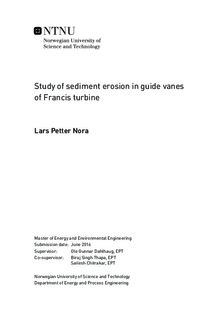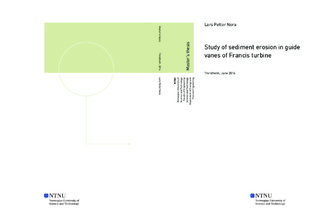| dc.description.abstract | The Himalayas and the Andes mountains are regions with some of the worlds
biggest hydropower potential. One of the biggest problems facing the development
of these resources are high concentrations of hard minerals in the water
streams. This causes severe sediment erosion in the hydraulic machinery. As
a result, the maintenance cost is increased and the power production decreases.
With a goal to learn more about this problem, NTNU and Kathmandu University
have initiated an large research cooperation. Together they have done a extensive
research on a Francis turbine in the Jhiruk Hydroelectric Centre in Nepal, which
operates with a high sediment load. As an extension of this research, a test rig
designed as a symmetric section of this turbine has been made at the Water
Power Laboratory at NTNU. The test rig, called the One GV Cascade, enables
researchers and students to carry out experiments and study the passages flow
conditions.
By carrying out a Computational Fluid Dynamics(CFD) and Particle Image
Velocimetry(PIV) analysis on this test rig, one can study in detail the flow
around different guide vanes(GV). Through comparing the CFD results with the
experimental results, it is possible to evaluate in detail how the different GV
geometries and clearance gap(CG) sizes will affect the flow. These results will
hopefully make it possible to propose an improved GV design that causes less
sediment erosion in the Francis turbine system.
This master thesis will describe the basic theory, procedures and results from
the CFD and PIV comparison. The main results shows that the new GV
design(NACA 4412) has much better flow conditions compared with the reference
design(NACA 0012). The new GV design creates a lot smaller pressure difference
between the suction and pressure side. The effect of this is also obvious with
15.7% lower clearance gap(CG) velocities, as well as a significantly smaller and
weaker vortex filament.
To further confirm these results further studies has to be done. By designing a
new test rig, with walls based on NACA 4412, the improved GV result can be
further validated. If the same results are obtained, NACA 4412 can be seen as
a promising improvement in the effort of removing one of hydropowers biggest problems.
Keywords: Francis turbine, guide vane, sediment erosion, PIV, CFD. | |

